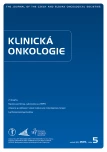Malignant Peritoneal Tumors – Introduction
Authors:
Petr Bartoška 1; František Antoš 1; Libor Nemec 2; David Hoskovec 3; Petr Dytrych 3; Miroslav Levý 4; Dušan Klos 5; Jiří Tomášek 6
Authors place of work:
Chirurgická klinika 1. LF UK a Nemocnice Na Bulovce, Praha
1; Klinika operační onkologie, Masarykův onkologický ústav, Brno
2; I. chirurgická klinika 1. LF UK a VFN v Praze
3; Chirurgická klinika 1. LF UK a Thomayerovy nemocnice, Praha
4; I. chirurgická klinika LF UP a FN Olomouc
5; Klinika komplexní onkologické péče, LF MU a Masarykův onkologický ústav, Brno
6
Published in the journal:
Klin Onkol 2019; 32(5): 324-328
Category:
Přehled
doi:
https://doi.org/10.14735/amko2019324
Summary
This article provides an introduction to peritoneal tumors, which are the subject of a series of review papers published in Issue 5 (2019) of Klinicka onkologie. Many malignant peritoneal tumors are characterized by production of mucinous and gelatinous masses, multiple peritoneal disability, so-called peritoneal carcinomatosis, and various grades of malignancy depending on their origin, staging, and histological type. Malignant peritoneal tumors are rare and their clinical symptomatology is nonspecific and varies according to the extent of disability. Diagnosis, particularly in the initial asymptomatic stages, is very complicated and often impossible, and tumors are often diagnosed by chance during other operations. Malignant peritoneal tumors were regarded as incurable and lethal for a long time; however, this view has changed over the past three decades. The Sugarbaker method, a combination of cytoreductive surgery and hyperthermic intraperitoneal chemotherapy, was introduced in the 1990s. Postoperative cytostatic lavage is usually performed in specific cases. Classifications for the extent of disease and completeness of cytoreduction were established. Studies repeatedly confirmed the efficacy of this treatment for peritoneal malignancy. The combination of an aggressive surgical approach and intraperitoneal chemotherapy not only enhances quality of life, but also prolongs progression-free survival and overall survival in selected patients. Specialized centers for treatment of peritoneal malignancy were established based on results from the Czech Republic and around the world. These centers provide complex care, including specific surgical interventions and follow-up, for selected patients with primary and secondary peritoneal malignancy.
Keywords:
peritoneal tumors – peritoneal metastases – cytoreductive surgery – intraperitoneal chemotherapy
Zdroje
1. Di Giorgio A, Pinto E (eds). Treatment of peritoneal surface malignancies. Springer-Verlag Italia 2015.
2. Sampson JA. Implantation peritoneal carcinomatosis of ovarian origin. Am J Pathol 1931; 7 (5): 423–444.
3. Klos D, Riško J, Stašek M et al. Současné postavení cytoredukční chirurgie (CRS) a intraperitoneální hypertermické chemoterapie (HIPEC) v multimodální léčbě nádorů peritoneálního povrchu. Cas Lek Cesk 2018; 157 (8): 419–428.
4. Yan TD, Haveric N, Carmignani CP et al. Abdominal computed tomography scans in the selection of patients with malignant peritoneal mesothelioma for comprehensive treatment with cytoreductive surgery and perioperative intraperitoneal chemotherapy. Cancer 2005; 103 (4): 839–849. doi: 10.1002/cncr.20836.
5. Koh JL, Yan TD, Glenn D et al. Evaluation of preoperative computed tomography in estimating peritoneal cancer index in colorectal peritoneal carcinomatosis. Ann Surg Oncol 2009; 16 (2): 327–333. doi: 10.1245/s10434-008-0234-2.
6. Jacquet P, Sugarbaker PH. Clinical research methodologies in diagnosis and staging of patients with peritoneal carcinomatosis. Cancer Treat Res 1996; 82 (3): 359–374.
7. Spratt JS, Adcock RA, Muskovin M et al. Clinical delivery system for intraperitoneal hyperthermic chemotherapy. Cancer Res 1980; 40 (2): 256–260.
8. Passot G, Bakrin N, Isaac S et al. Postoperative outcomes of laparoscopic vs open cytoreductive surgery plus hyperthermic intraperitoneal chemotherapy for treatment of peritoneal surface malignancies. Eur J Surg Oncol 2014; 40 (8): 957–962. doi: 10.1016/j.ejso.2013.10.002.
9. Wittekind C, Compton C, Quirke P et al. A uniform residual tumor (R) classification: integration of the R classification and the circumferential margin status. Cancer 2009; 115 (15): 3483–3488. doi: 10.1002/cncr.24320.
10. Jacquet P, Sugarbaker PH. Clinical research methodologies in diagnosis and staging of patients with peritoneal carcinomatosis. Cancer Treat Res 1996; 82: 359–374. doi: 10.1007/978-1-4613-1247-5_23.
11. Sugarbaker PH. Peritonectomy procedure. Ann Surg 1995; 221 (1): 29–42. doi: 10.1097/00000658-199501000-00004.
12. Sugarbaker PH. Cytoreductive surgery and peri-operative intraperitoneal chemotherapy as a curative approach to pseudomyxoma peritonei syndrome. Eur J Surg Oncol 2001; 27 (3): 239–243. doi: 10.1053/ejso.2000.1038.
13. Sugarbaker PH. New standard of care for appendiceal epithelial neoplasms and pseudomyxoma peritonei syndrome? Lancet Oncol 2006; 7 (1): 69–76. doi: 10.1016/S1470-2045 (05) 70539-8.
14. Franko J, Shi Q, Meyers JP et al. Prognosis of patients with peritoneal metastatic colorectal cancer given systemic therapy: an analysis of individual patient data from prospective randomised trials from the Analysis and Research in Cancers of the Digestive System (ARCAD) database. Lancet Oncol 2016; 17 (12): 1709–1719. doi: 10.1016/S1470-2045 (16) 30500-9.
15. Ansari N, Chandrakumaran K, Dayal S et al. Cytoreductive surgery and hyperthermic intraperitoneal chemotherapy in 1000 patients with perforated appendiceal epithelial tumours. Eur J Surg Oncol 2016; 42: 1035–1041. doi: 10.1016/j.ejso.2016.03.017.
16. Mehta SS, Gelli M, Agarwal D et al. Complications of cytoreductive surgery and HIPEC in the treatment of peritoneal metastasis. Indian J Surg Oncol 2016; 7 (2): 225–229. doi: 10.1007/s13193-016-0504-6.
17. Kusamura S, Moran BJ, Sugarbaker PH et al. Multicentre study of the learning curve and surgical performance of cytoreductive surgery with intraperitoneal chemotherapy for pseudomyxoma peritonei. Br J Surg 2014; 101 (13): 1758–1765. doi: 10.1002/bjs.9674.
18. Baratti D, Kusamura, Pietrantonio F et al. Progress in treatments for colorectal cancer peritoneal metastases during the years 2010–2015. A systematic review. Crit Rev Oncol Hematol 2016; 100: 209–222. doi: 10.1016/ j.critrevonc.2016.01.017.
19. van der Speeten K, Stuart OA, Sugarbaker PH. Using pharmacologic data to plan clinical treatments for patients with peritoneal surface malignancy. Curr Drug Discov Teachnol 2009; 6 (1): 72–81.
Štítky
Detská onkológia Chirurgia všeobecná OnkológiaČlánok vyšiel v časopise
Klinická onkologie

2019 Číslo 5
- Metamizol jako analgetikum první volby: kdy, pro koho, jak a proč?
- MUDr. Lenka Klimešová: Multiodborová vizita je kľúč k efektívnejšej perioperačnej liečbe chronickej bolesti
- Nejasný stín na plicích – kazuistika
Najčítanejšie v tomto čísle
- Alopecie a poškození vlasů indukované onkologickou terapií
- Pseudomyxom peritonea
- Maligní peritoneální mezoteliom a jeho léčba
- Maligní nádory peritonea – úvod do problematiky
